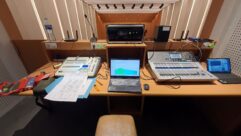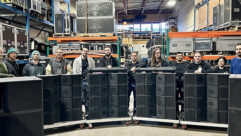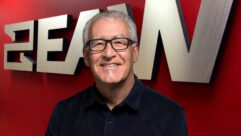
Sound Advice: Put IT in Your Toolbox
Mar 1, 2008 12:00 PM,
By Dan Daley
The covergence of AV and IT has arrived.

To drive sales, AV manufacturers are integrating the force of IT systems with AV systems, accelerating the growth of IT-based products and the need for integrators to be proficient in networking technologies.
There’s a new posse of products in town, and they augur a significant change in the way audio-systems integration is going to evolve over the next few years. HiQNet, QSC Basis, NetMax, and other high-tech contractions with Ritalin-influenced case sensitivity are clearing the path for true convergence between sound and IT systems integration.
“I have basically been told that if we don’t have a network administrator on our install team, we should get one,” says Ben Stowe, a certified technology specialist at NothernLightFX, a systems sales, design, and install company in central Minnesota. “Technologies like Basis/Rave, NetMax, and others put the writing on the wall. I think when you look at the growing number of digital consoles and Pro Co’s new [Momentum] digital snake, as well as the number of PoE [power over Ethernet] devices coming out lately, it’s clear that absolute integration is not the way of the future — it’s already here.”
This seems to be a manufacturer-driven phenomenon — an instance in which companies have made the effort to look over the horizon. QSC, Harman, Bosch (whose acquisitions of EV, Dynacord, Telex, Midas, and Klark Technik combined with its already robust and advanced security systems make it a calculating and formidable player in all types of installed systems), and other companies have used their proprietary protocols as a marketing strategy to advance their group sales, but a significant collateral to this has been the acceleration of IT as an element of systems installations.
In the process, it transforms the companies. For example, QSC is no longer an amplifier maker but a systems developer. QSC Basis and DSP 322ua devices all operate under its QSControl.net protocol, and they are networked and controlled from its Venue Manager software, allowing multiple networked computers to control and monitor all compliant units on the system simultaneously. What’s more, some of these systems, while proprietary to the manufacturer, are nonetheless compatible with the embedded system-control protocols in both residential and commercial systems installations. For instance, QSControl.net is compatible with both AMX and Crestron controllers.
The fact that post-acquisition Bosch put its newly acquired pro-audio group of brands under the auspice of its security systems group underscores how security systems — which are very much IT-centric these days — are one of the ways that IT is being braided into the wired strands of AV systems. In the process, Bosch, like other manufacturers, is making it abundantly clear that it expects integrators to be able to make audio talk to the alarm and even to the refrigerator and the coffee maker (which Bosch also makes) on demand.
Proprietary systems are a good thing, according to the people who make them. “The concept of putting all of your equipment onto a common network can bring some pretty significant benefits for all parties involved, from the integrator to the end user,” says Ethan Wetzell, technical product manager for the NetMax/Iris-Net systems at Bosch. “There are cost and labor savings that can be found by using a common infrastructure, such as a fiber-optic and IT-based backbone. Maintenance can be consolidated, streamlined, and made more effective. Expansion and additions to the system can be easier and less costly. There are also some nut- and-bolts benefits for the integrator, as well — a fiber-optic backbone can be run further and in lower density than analog over copper, and it is immune from nasty things such as RFI and EMI. Systems can be remotely monitored and supervised, leading to a reduction in service calls and more effective sales of service plans, which can be a great opportunity for additional revenue.”
This convergence is also going to have economic and operational implications for audio integrators. “You’re going to be competing with people you never did before, like security-systems installers,” Stowe says.
Indeed, security-system installers have emerged as a catchall resource for many builders, replacing a collection of other low-voltage specialists, such as home-theater and structured-wiring installers.
“I just got a call from a builder who asked us to install complete home-theater systems in their new homes,” says Greg Simmons, vice president of systems integrator Eagle Sentry in Las Vegas. “That would have been a very surprising request for a security installer even five years ago.”
Security systems’ integration with IT is directing this evolutionary path. AV integrators need to become aware of it and change their own professional DNA. Education is key, and it’s reasonable to suggest that systems manufacturers are a cost-effective, if somewhat product-centric, place to start.
“Our view has been for some time that convergence is inevitable,” says Steve Metzger, vice president of business development at Biamp Systems, adding that the company has developed its own educational services and infrastructure in support of that view. “For several years, our products have leveraged networking technologies for communications, control, and signal distribution. As the two fields continue to converge, the need exists to continually refresh the training content because of the changing nature of the technology and the people who attend.”
“I always tell my students that there are three categories of IT technology: the stuff that’s high-level IT that you will probably never need to know about to do your AV part; the stuff that’s nice to be aware of because it’s probably going to come up at some point; and the stuff that you absolutely can’t do the job without understanding,” Wetzell says. “I still come across quite a lot of people in the AV industry who are wrestling with that third one.”
Michael MacDonald, executive vice president of marketing at Harman Pro Group, agrees. “The convergence of AV and IT has been an issue for contractors for some time now — and not just on a technical level, but also a commercial level,” he says. “As digital technologies have driven the convergence of AV and IT, programming has become a primary function of system integrators. But with such a diverse array of technologies, protocols, and platforms, it’s been difficult for systems integrators to be proficient on all of the platforms, and it’s become equally challenging to accurately estimate programming time on bids and estimates. As such, effective programming impacts the effectiveness of a system and the [profit and loss] of a project.”
Metzger says Biamp recently enlarged its Oregon-based Beaverton Learning Center and launched select classes for Spanish speakers. The company will also replicate the programs and infrastructure used in the Beaverton facility in three new international training locations, and new classes for advanced skills are being added to the training schedule. The course offers an interactive program focused on hardware, software, and the practical application of both. Biamp also issues monthly newsletters and provides training on its website, www.biamp.com.
Moving forward, audio — like video — is going to relate less to data in a signal-versus-control relationship than in the kind of parity that is characteristic of digital technology. Everything will ride the same wire — or Wi-Fi signal — at some point. Start getting ready for it now.
Audio ColumnistDan Daleywas a partner and CFO at Pyramid Recording Studios in New York, where he also engineered records and audio for television, including MTV’s The Big Show.










